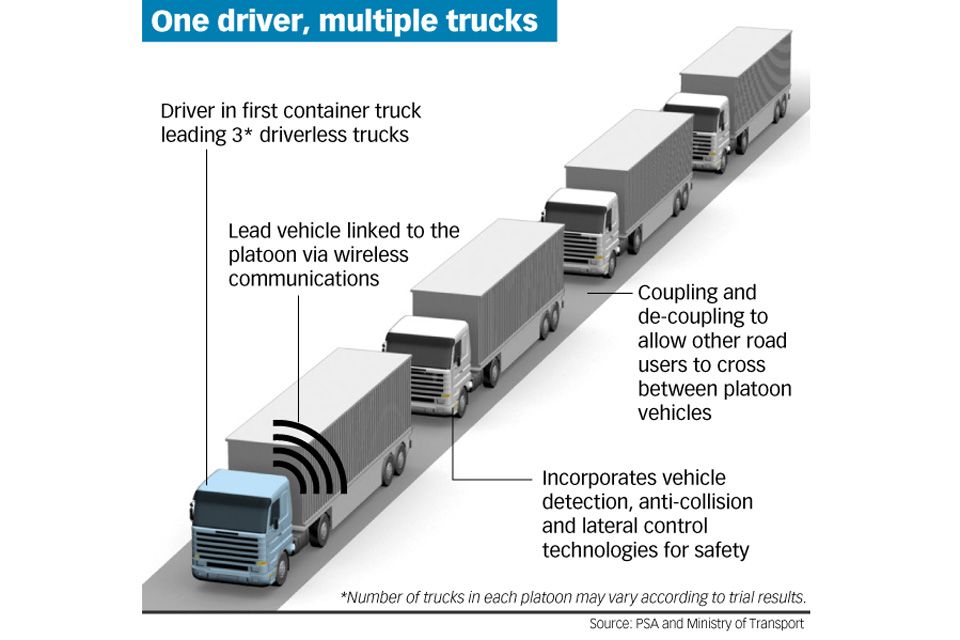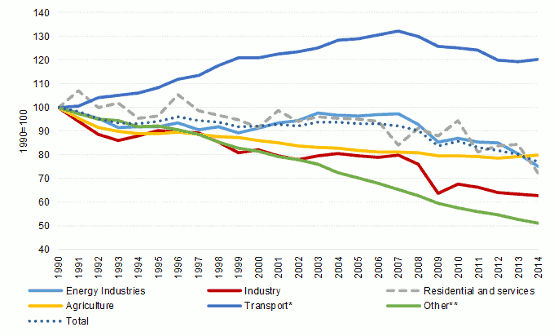The European Truck Platooning Challenge: Transforming Europe’s Road Transport on Autopilot

Flanders and the European Commission are taking important steps in using digital to reduce the carbon footprint of road transport. The European Truck Platooning Challenge provides an inspiring case in point.
On a typical Belgian drizzly Tuesday morning in April 2016, Ben Weyts, Flemish Minister of Mobility, stepped into the cabin of a Volvo truck. He was about to ride along for a test drive on the E19 Highway from Brussels to Antwerp. The many screens in the truck sparked his curiosity – it bore the faint resemblance of an airplane cockpit. Only weeks before, his administration issued a special decree to allow Volvo, IVECO and DAF to drive their trucks on Flanders’ roads in convoys of 2 or 3 vehicles no more than 72 feet apart, less than half of the legal minimum of 164 feet. The decree allowed truck manufacturers to compete in the first European Truck Platooning Challenge.
The Challenge was introduced by The Netherlands as part of their six-month Presidency of the Council of the EU. The Dutch had announced the Truck Platooning Challenge as a crucial step towards moving to a smart, digitized and low-emission mobility system in the EU. Six major truck manufacturers were challenged to drive truck platoons from and through a range of European countries to arrive at the port of Rotterdam on April 6, 2016 [1].
Truck platooning is spearheading the digitization of freight transport. It combines connected vehicle and self-driving technology to have trucks drive bumper-to-bumper in a convoy or column, reducing total wind resistance and fuel consumption significantly (see exhibit 1).

Air drag accounts for up to 25% of a truck’s total fuel consumption. The closer trucks can drive to each other, the greater the fuel saving potential [2].
The technology is emerging as an answer to many major challenges of long distance road freight transport and is key to efficiency improvement and cost reduction, decarbonization, logistics chain improvement, road safety and infrastructure capacity.
Transport represents almost a quarter of Europe’s greenhouse gas emissions and is the main cause of air pollution in cities. Moreover, the transport sector has not seen the same gradual decline in emissions as other sectors: emissions only started to decrease in 2007 and still remain higher than in 1990 (see exhibit 2). Transport is the only major sector in the EU where greenhouse gas emissions are still rising. Within this sector, road transport is by far the biggest emitter accounting for more than 70% of all greenhouse gas emissions from transport in 2014 (see exhibit 3) [3]. Working to reduce the freight transport CO2 emissions through digitization makes particular sense in Belgium and Flanders, situated in the heart of Europe and crossed intensely by pan-European road transport. Without policy action, the CO2 emission from trucks and buses would rise with 10% over the 2010 – 2030 time period, putting additional pressure on Europe’s commitments in the Paris climate agreement [4].


According to minister Weyts: “We, as a road authority, have to change our focus. We have to deal with and establish a smarter road. We are not simply a construction operation anymore. We are a road authority 2.0. The road authority of the future.” [5]
Creating a regulatory framework for truck platooning is one of many steps the Flemish Ministry of Mobility is undertaking to help Europe fight its battle against climate change. The Platooning Challenge has highlighted the importance of international collaboration in establishing a regulatory framework for digital mobility and supply chain options and the EU is working to be able to deploy these systems coordinated and swiftly [6].
Going forward, minister Weyts should expand and accelerate his efforts to ensure Flemish law allows for permanent testing of truck platooning. Moreover, he should lead the effort to adapt and modernize European Traffic Law to the digitization of road transport. Case in point is the 1968 Vienna Convention on Road Traffic, stipulating much of the EU member states’ traffic law: it prescribes a minimum inter-truck driving distance of 164 feet, as opposed to the 72 feet or less aimed for in truck platooning [7].
As a result, truck manufacturers need to apply for and obtain a one-time ministerial decree for every test of platooning technology on public roads. Second, a pan-European regulatory framework needs to be set up and ratified to allow for platooning across national borders and truck brands, eliminating the need for a permit from each member state individually.
Questions
Key questions policymakers should take into account as they continue to digitize the road freight transport system include the degree of autonomy and a clear view on accident liability.
Will we as a society be ready to have fully autonomous trucks driving on our roads in the near future? How will we help our current drivers of the 13 million truck fleet find new employment? [8] How will we ensure the right party is held liable in case of an accident – truck manufacturer, transport company or third party involved?
(Word count: 796)
Endnotes
[1] European Truck Platooning, “Corridors To Drive – EU Truck Platoon Challenge”, https://www.eutruckplatooning.com/About/Corridors+to+drive+MAP/default.aspx, accessed November 2017
[2] Volvo Group, “Trucks on a European Tour for Platooning”,
http://news.cision.com/volvo/r/trucks-on-a-european-tour-for-platooning,c9937051, accessed November 2017
[3] European Commission, “Reducing Emissions from Transport”,
https://ec.europa.eu/clima/policies/transport_en, accessed November 2017
[4] European Commission, “Reducing CO2 emissions from Heavy-Duty Vehicles”, https://ec.europa.eu/clima/policies/transport/vehicles/heavy_en, accessed November 2017
[5] Dutch Ministry of Infrastructure and the Environment, “European Truck Platooning Challenge 2016”, https://www.eutruckplatooning.com/support/storybook/default.aspx#folder=501159, accessed November 2017
[6] European Commission, “A European Strategy for Low-Emission Mobility”,
http://eur-lex.europa.eu/legal-content/en/TXT/?uri=CELEX:52016DC0501, accessed November 2017
[7] Althoff M, Lösch R, “Can automated road vehicles harmonize with traffic flow while guaranteeing a safe distance?”,
2016 IEEE 19th International Conference on Intelligent Transportation Systems
[8] Inconvenient Truck, “The Economics of the trucking industry”,
https://inconvenienttruck.eu/the-economics-of-trucks-industry/”, accessed November 2017



Thanks for an interesting article, Jan. I hadn’t heard about this before, but I did a bit of research and it looks like platooning is also being tested in the US. I think I’d find it shocking to see trucks so close together on the highway, but I understand the need for reducing emissions and improving fuel efficiency. Aside from the obvious benefits in terms of environmental impact, I wonder how platooning will impact shipment patterns. As companies are pressed to shorten lead times between order and delivery, it becomes harder for companies to ship full truckloads, but operating at capacity is critical from a cost savings standpoint. If companies are now attempting to fill 2-3 trucks instead of one, I wonder whether this will slow down delivery timetables – a result that few customers would be willing to accept in the age of Amazon same-day delivery.
This article also discusses the question of who companies will choose to platoon with: http://www.truckinginfo.com/channel/fuel-smarts/article/story/2016/04/platooning-is-on-the-way.aspx
While the preference to build platoons within their own fleet, it seems like this may be unrealistic in some settings – especially for the smaller operators who will certainly need to adopt any cost-saving processes in order to remain competitive. As companies look to form platoons across fleets, who will be responsible for coordinating and managing the platooning process? Fleet operators and logistics companies seem well positioned to do this, but is coordinating across customers going too far? They’ll need to be careful to protect companies’ privacy regarding frequency and content of shipments while also pairing them up with other companies making similar journeys.
Interesting read on the future of truck driving and how it addresses the trend of digitization in the supply chain. I think there is a huge potential for enhanced efficiency in the supply chain as we incorporate autonomous vehicles, particularly as it relates to trucks and shipping. There is currently a short supply of truckers and furthermore, restrictions on how long truckers can drive for (due to health and legal reasons), both of which will be addressed with the incorporation of self-driving trucks. Not only will utilization increase, but once the technology is well-tested, it could have significant implications for safety reasons as well (no human error, no lives at risk, etc.). I’m excited to see where this trend goes and to see how it impacts across industries.